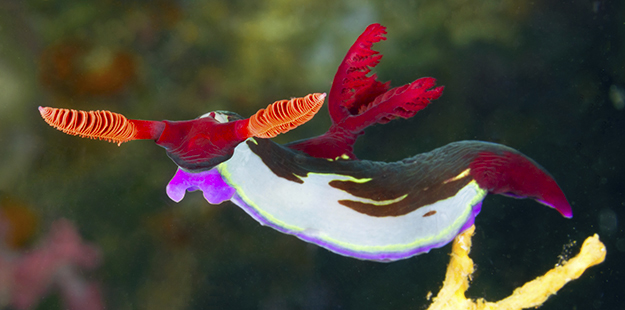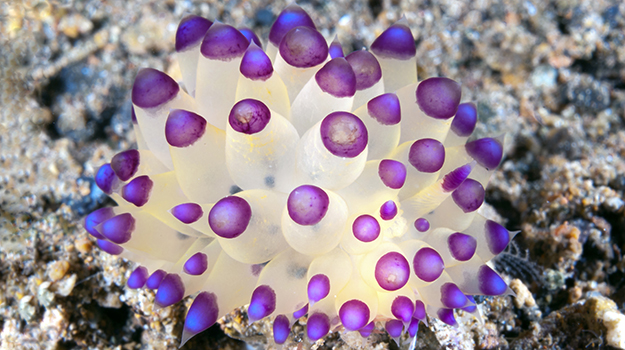Butterflies of the Sea
Nudibranchs add dazzling displays of color to our reefs
Searching for sea slugs doesn’t sound like a glamorous activity. Unless the slugs in question are nudibranchs. That’s a whole different matter. Divers, and especially underwater photographers, take great delight in tracking down and identifying these colorful little critters, and the nudibranch’s bright hues and intricate patterns have earned them the nickname “butterflies of the sea.” That being the case, the reefs of Wakatobi could be considered the equivalent of an underwater butterfly garden, as they are home to a diverse and visually exciting collection of nudibranchs.

Tentacles above the nudibranch’s head are known as rhinophores, seen on this member of the dorid family. They are used to taste, touch and smell. Photo by Walt Stearns

The nudibranch group known as aeolids have spike to feathery like growths called cerata sprouting across their back and down their sides. Photo by Walt Stearns
Naked snails
Nudibranchs are mollusks belonging to the gastropod family, which is primarily made up of snails. These aquatic cousins of the snail choose to live outside the shell, shedding their body armor during the larval stage, or sometimes while still inside the egg, and spending their adult lives with their soft bodies exposed to the elements. They take their name from the Latin nudus, as in naked, and the Greek word for gills: brankhia. The nudibranch’s exposed, naked gills come in a variety of shapes. The most classic is a bushy, plume-like growth on the dorsal side (back) set near the animal’s rear end, belonging to the group biologically known as dorids. A second group, known as the aeolids, feature spike to feathery like growths known as cerata sprouting across their back and down their sides. Between these two primary groups, the differences in gill configuration and placement has given rise to such an astonishing range of manifestations that some of the well over 3000 known species that inhabit the world’s oceans don’t even look real.
Life in the slow lane
Like snails, nudibranchs live in the slow lane, propelling themselves across the sea floor at a blistering speed of up to 30 feet a day on a foot-like muscle (where the term gastropod comes from), leaving a slime trail as they travel. Good thing they don’t move very fast as they just might run into something; nudibranchs are also nearly blind. The tiny eye spots on their front ends can tell light from dark, but little else. Most of their environmental information comes from other senses. The two stalks atop the head are rhinophores, appendages design to basically taste chemical traces in the water similar to the way we use our noses to sniff out pleasantries in the air. They are also sensitive to touch. If a nudibranch senses danger, it will withdraw these tentacles to keep them from getting munched by a passing fish.
You might think that a soft and seemingly defenseless animal that can’t see threats coming -and couldn’t escape even if it did- would do well to hide. And in fact some nudibranchs do take on the drab colors of their surroundings, in order to avoid attention. But far more often, these slow-moving slugs sport bright colors and bold patterns that help them stand out like glittering gemstones. This chromatic excess is actually a survival strategy, the biological equivalent of a HazMat warning sign. Turns out, a nudibranch will leave a very bad taste in the mouth.

Sporting bright colors and bold patterns in order to stand out is actually a nudibranch’s survival strategy, the logical equivalent of a HazMat warning sign. Why? A nudibranch will leave a very bad taste in the mouth of it’s predator. Photo by Marcus Lindenlaub

An animal this slow moving would be considered primarily a grazer, however, nudibranchs are actually carnivores. Photo by Richard Smith
Foul fare
Nudibranchs spend most of their time chasing down a meal. They typically feed for up to 18 hours a day, and spend the remaining time at rest. You might expect an animal this slow moving to be primarily a grazer, but aside from the occasional nosh of algae, nudibranchs are primarily carnivores and their mouths have a hard, tooth-like growth known as a radula that is used to crush their prey. Since they stand little chance of catching anything that moves, they focus on things that can’t, including sponges, anemones, hydroids, corals, barnacles, fish eggs and sometimes each other. Most sea creatures would find the majority of a nudibranch’s diet to be foul tasting or even poisonous, but these slugs use that to their advantage. Nudibranchs often retain the foul tastes of their prey, making themselves unpalatable in return.
Nudibranchs stand little chance of catching anything that moves, so they focus on things that can’t, including sponges, anemones, hydroids, corals, barnacles, fish eggs and sometimes each other.
There are a number of strategies nudibranchs employ to keep themselves off the menu. Many are able to secrete acids that render them distasteful, while others process and repackage the chemical defenses of their own prey. Nudibranchs will feed on sponges that are poisonous to other animals, assimilating the toxins into their own bodies to render themselves unpalatable. A number of species that feed on hydroids, jellyfish and anemones can actually store the stinging nematocyst cells in their body without harming themselves, then concentrate those hydroids into the tips of their spike-like cerata. Some species even concentrate the stingers into projectiles that can be spit at would-be attackers. It’s not clear exactly how nudibranchs are able to survive on a diet of poison and stingers, but it is believed that they have developed specially protected cells in their buts with thick membranes that contain the toxins.


